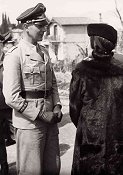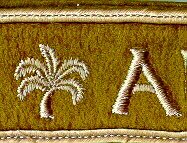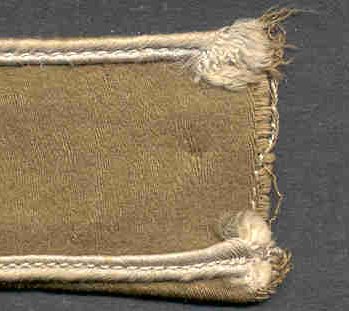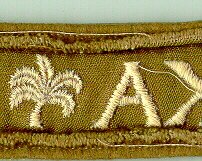
by COL Scott Pritchett
GENERAL DESCRIPTION
The AFRIKA cuffband design follows the general pattern of the majority of cuffbands/cufftitles designed and worn by the Heer, and many of those designed and worn by the Luftwaffe, in that it features a title word in machine embroidery on a length of cloth between two strands of Russia braid. There were no style differences for rank, although it can be assumed that officers, who were responsible for their own uniforms and generally were able to provide for private purchase fabrications, were most likely to have examples executed in higher quality materials. In particular, the AFRIKA cuffband features a central title word - "AFRIKA" - embroidered in Roman-style block lettering between to stylized palm trees - with the entire length of the top and bottom edges of the cuffband bordered in Russia braid. As a cuffband that all branches of the Wehrmacht were entitled to wear - but that the Luftwaffe and Heer were the main recipients of - it makes sense that its general design and construction would follow those developed by these two branches of service. A full length, or unissued cuffband, will measure approximately 45 mm long, but many available to collectors will be shorter, particularly if removed from a uniform. This shortening usually occurs because the individual removing the cuffband did not take the time to cut through the threads that join the ends along the vertical. In some cases, the cuffband was actually sewn in to the sleeve seam, making a neat removal all the more complicated. The width of the cuffband will measure 33 mm, which is standard for many issue cuffbands/cufftitles. However, a collector should not be concerned if the actual width varies slightly, as cloth measurement can involve some 'eyeballing'.
Original examples of the AFRIKA cuffband are moderately scarce on the collector's market. Given that approximately 100,000 veterans of the North African campaign were in service on the continent at institution, that about 125,000 to150,000 Wehrmacht, Heer and Luftwaffe soldiers were taken POW and that about 3,400 were missing in action, one can conclude that during the roughly eighteen to twenty months of official production, perhaps less than a million were produced to cover an immediate/known demand of about 500,000. Many available to collectors today are in fact unissued pieces, indicating that in any case, the total of the production runs had to have exceeded the requirements. Additionally, manufacturers could not have accurately forecasted the termination of awards in late 1944, so production initially would not have been constrained by this fact.
It should be noted for collectors that the Luftwaffe instituted a similar, but purely Luftwaffe cufftitle for its members that were serving in North Africa. This cufftitle features white Latin lettering on a dark blue backing in either cotton or silver embroidery. It is a unit cufftitle denoting service with a unit performing service in or over the North African theater and, as such, should be considered a piece of insignia. The Luftwaffe AFRIKA cufftitle was authorized in March 1942.
Click on image to enlarge
 |
Photo of a pilot, in tropical dress, wearing the Luftwaffe unit/service recognition cufftitle - AFRIKA. |
Similarly, the Kriegsmarine seems to have developed its own unofficial version for wear, even though the standard, award issued piece was authorized for this service. Perhaps because the award issue version was a tan color, it affronted the sensibilities of the traditions-bound Kriegsmarine and led some members to obtain these unofficial awards in a color combination that coordinated better with the navy blue uniform. Alternatively, it may have been that these unofficial awards came about ahead of the official piece, as photographic evidence tends to show them in wear in the Mediterranean. Examples followed to same basic design of the standard award issued piece, having the dual palm trees with the AFRIKA text - except in gold cotton thread machine or wire hand embroidery - motif and soutache braid on a navy blue background.
Click on image to enlarge
The description that follows is for the standard issue AFRIKA cuffband. Legitimate variations are covered toward the end of the article, but are few indeed.
DETAILED DESCRIPTION OF THE OBVERSE

The width is 33mm. The camelhair cloth (Kamelhaar Ausführung) is medium tan in color and smooth in appearance and touch. As in most Heer cufftitles, the designers seem to have relied on a degree of symbolism in selecting the materials and motif. From the choice of camel hair, the colors used, the suggestion of the DAK symbol in the palm tree, to the style of lettering selected, the design of the cuffband tells its own story.
The standard issue piece has the Roman lettering executed in a silver-gray, machine embroidered cotton thread. The quality of the machine embroidery is moderately high, but generally not of a superior quality. However, the execution is tight and should show some slight curvature to the relief on the letters. Close observation will generally reveal some jaggedness to the letters since the tightness of the weave tends to pull at the camel hair base cloth. The vertical strokes of the letters are embroidered with stitching that runs horizontal. The horizontal strokes have the embroidery running vertical and the embroidery of the curved stroke of the 'R' will fan from vertical on the ends to horizontal in the middle. A characteristic of the flared ends on all of the letters of an original example, are that they are embroidered very straight to the horizontal or vertical. Letter measurements at their tallest and widest measurements average closely the dimensions as shown below:
| A | 16mm tall x 18 mm wide |
| F | 16mm tall x 11 mm wide |
| R | 16mm tall x 11 mm wide |
| I | 16mm tall x 4 mm wide |
| K | 16mm tall x 19 mm wide |
|
A |
16mm tall x 18 mm wide |
The two palm trees bracketing the title word 'AFRIKA' are executed in the same silver-gray cotton thread. The trees should be mirror images of one another, the left tree - as seen by the viewer - bending over to the right, and the right tree bending to the left. Each tree features five curved palm leaves - two on either side of a central leaf - fanning out from a curved trunk. The overall dimensions of the palm trees measures 18mm tall by 17mm wide at their largest dimensions. The leaves are each serrated along both edges and are embroidered such that the center seams appear hollow.
 |
Close up of the palm tree. |
The Russia braid or soutache' that lines the top and bottom edges of the cuffband along the entire length is silver-gray in color. Original, standard issue cuffbands will invariably have this braid accurately, straight machine sewn and tangent to the edges of the base cloth. The machine stitching is typically very straight but may be biased/off center toward the inside edges of the Russia braid. Russia braid is 3mm wide.
The ends of this cuffband, like most, are an important, but often overlooked area when inspecting for originality. If the collector is fortunate enough to have a full-length example, it will usually show a finishing stitch along the cut edge running horizontally between the lengths of Russia braid. However, the cut ends, regardless of length will usually show some degree of unraveling, with the soutache braid unraveled to show the fluffy, off-white, cotton interior.
 |
Note the last remnants of the vertical machine stitching that denotes the end of the full length cuffband - where it would have been cut from a roll of cloth bands. |
DETAILED DESCRIPTION OF THE REVERSE

The edges of the base cloth are folded over on to the reverse to a depth of about 7mm to 10 mm. The cut inside edges of this folded portion will not necessarily be cut completely straight. The cut edges also may or may not have a loose basting stitch to secure the fold over to the reverse. Showing through the fold is the machine stitching from the front that secures the Russia/soutache braid.

Another example cuffband - showing typical wear and tear to the reverse from being worn.
The machine embroidered lettering and palm trees as seen from the reverse of the cuffband are a mirror image of the front. The color of the embroidery shows white rather than silver-gray due to the under stitching of the embroidery. Lengths of thread left over from the embroidery, with free running ends, are commonly seen and are not indications of reproductions.
 |
Close up of the palm tree and lettering in reverse. |
![]()
© Copyright Wehrmacht-Awards.com LLC |
